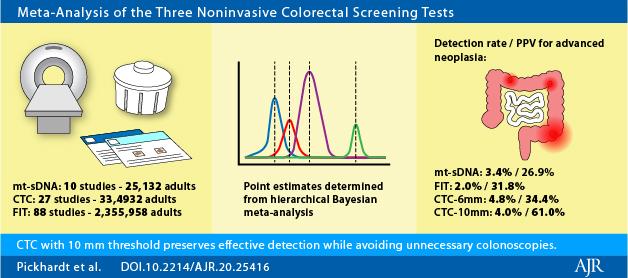Compared with multi-target stool-DNA and fecal immunochemical test, CT colonography with 10 mm threshold most effectively targets advanced neoplasia–preserving detection while decreasing unnecessary colonoscopies

Credit: American Roentgen Ray Society (ARRS), American Journal of Roentgenology (AJR)
Leesburg, VA, March 12, 2021–According to an open-access article in ARRS’ American Journal of Roentgenology (AJR), compared with multi-target stool-DNA (mt-sDNA) and fecal immunochemical test (FIT), CT colonography (CTC) with 10 mm threshold most effectively targets advanced neoplasia (AN)–preserving detection while decreasing unnecessary colonoscopies.
“CTC performed with a polyp size threshold for colonoscopy referral set at 10 mm represents the most effective and efficient non-invasive screening test for colorectal cancer (CRC) prevention and detection,” clarified first author Perry J. Pickhardt from the department of radiology at the University of Wisconsin School of Medicine & Public Health.
Because the relative performance characteristics of available noninvasive tests had not yet been adequately compared, Pickhardt’s team systematically searched PubMed and Google Scholar, including 10 mt-sDNA, 27 CTC, and 88 FIT published screening studies involving 25,132, 33,4932, and 2,355,958 asymptomatic adults, respectively. To determine test-positivity rates (TPR) leading to optical colonoscopy (OC), as well as positive predictive value (PPV) and detection rate (DR) for both AN and CRC, meta-analysis with hierarchical Bayesian modeling was conducted, in accordance with Cochrane Collaboration and PRISMA guidelines.
Pickhardt and colleagues’ results showed that CRC prevention via screen detection of AN was highest with CTC, followed by mt- sDNA, and lowest with FIT due to the differing TPR and PPV, although overlap existed in the 95% CIs when accounting for uncertainty. Compared with mt-sDNA and CTC6, FIT and CTC10 strategies yielded substantially lower colonoscopy resource utilization, while mt-sDNA performance appeared to be similar to FIT at low positivity thresholds.
Acknowledging that each CRC screening option has relative advantages and disadvantages that should be carefully considered and tailored to the individual, “in the end,” the authors of this AJR article concluded, “the ‘best’ test may be the one that the patient is willing to undergo.”
An electronic supplement to this article is available here: https:/
###
Founded in 1900, the American Roentgen Ray Society (ARRS) is the first and oldest radiological society in North America, dedicated to the advancement of medicine through the profession of radiology and its allied sciences. An international forum for progress in medical imaging since the discovery of the x-ray, ARRS maintains its mission of improving health through a community committed to advancing knowledge and skills with an annual scientific meeting, monthly publication of the peer-reviewed American Journal of Roentgenology (AJR), quarterly issues of InPractice magazine, AJR Live Webinars and Podcasts, topical symposia, print and online educational materials, as well as awarding scholarships via The Roentgen Fund®.
Media Contact
Logan K. Young
[email protected]
Original Source
https:/
Related Journal Article
http://dx.




